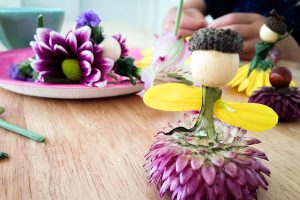The upcoming autumnal equinox (in the Northern hemisphere,) or Mabon, is a perfect opportunity to create a ceremony to mark a seasonal transition. Ceremony is a sacred and active prayer that opens communication with spirit. It can be as modest or elaborate as you'd like, as long as you infuse your ritual with clear intention and heartfelt meaning. Here is a loose guideline for a very simple, personal autumn equinox ceremony:
1) Gather materials: You'll need your journal, a piece of scrap paper, pen, candle, lighter, favorite scents (oils, smudging plants) and any other objects that speak to you in this moment (stones, bells, photos, jewelry, flowers, etc.)
2) Carve out a sacred space. It can be in your home or yard, the forest or beach -- anywhere! You may wish to create a small autumn altar on a shelf, table, or near your yoga mat or meditation space. If outside, you might use a stone or tree stump as an altar, or create a beautiful spot at the base of a tree. Place your special candle on your altar. You might also include seasonal objects you've gathered, such as leaves, acorns, stones, fruits.
3) Set your intention for autumn. Reflect on what you want to manifest by writing or making art in your journal. Then write a your intention statement on a small piece of paper to use in ceremony. You may wish to flow with the energy the fall equinox offers naturally, such as:
- Recognizing and honoring the balance of the light and dark within you, as there are equal hours of each on this special day.
- Harvesting, expressing gratitude for, and celebrating the bounty and abundance from the seeds you've sewn earlier this year.
- Soulful planning for the cooler, darker, introspective months ahead. The seed you plant now can bloom next spring.
- Making a commitment to open your inward eye during these darker months, discovering more about your unfolding, authentic self.
- Replenishing yourself - mind, body, and spirit. As reflected in the plant and animal life around us, we are also moving into the time for dormancy, hibernation, rest, and renewal.
- In this season of roots, spend time honoring your ancestors, calling on them for guidance or protection.
4) Open the ceremony by marking the time as sacred using a symbolic act. This can be done any in any of the following ways: Crossing a threshold; lighting the candle on your altar; sounding a bell, gong, drum, or rattle; using a scent to bring you into the dreamtime (diffusing or anointing with essential oils, lighting sage or palo santo, misting rose water, etc.)
5) Now call your guides into the space. Your personal guides might be your spirit guides, angels, gods/goddesses, animal spirits, ancestors or any un/seen entity that feels good and clear to call on in support of your highest good and your intention.
6) Cast a circle, calling upon all directions. You can do this however you prefer. I like to speak the following:
Facing east: "Spirit of the east, great spirit of air, cleanse this space."
Facing south: "Spirit of the south, great spirit of water, bring peace to this space."
Facing west: "Spirit of the west, great spirit of fire, energize this space."
Facing north: "Spirit of the north, great spirit of earth, ground this space."
Directed upward: "Great father sky, protect this space from above."
Directed downward: "Great mother earth, nurture this space from below."
7) Say your intention aloud and/or meditate on it like a mantra. Allow the intention statement to flow through your body in both directions -- inhaling the earth's energy up from the bottom of your feet (or base of your spine if sitting) from root to crown until it ascends from the top of your head to the heavens. Then exhale it down from crown to root, grounding your intention into the fertile soil of the earth.
8) Place the small paper with your intention on your altar. I often place mine under a candle or a stone to ground and enliven it.
9) Close the ceremony circle by offering gratitude to your guides. Also you may want to repeat or reverse the act you chose for opening your ceremony, such as snuffing the candle or herbs, sounding the bell, or crossing back over your threshold.
10) Allow the ceremony live in you as you move through the season ahead. Interact with your altar and/or journal, revisiting your intention and noticing the ways you are actively manifesting it in your life.












